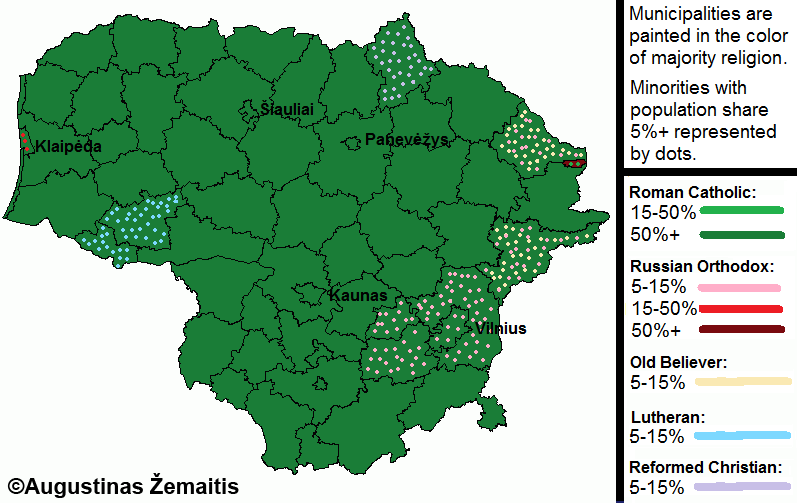Religion in Lithuania: An Introduction
In the globalized world of 21st century, few would be surprised by multi-religious cities. However, in Lithuania, the multi-religious atmosphere is centuries old. The 19th century Vilnius had temples of over 10 different religions, many of them non-Christian. Lithuania is a unique crossroad of the East and the West in that here you can see the centuries-old heritage of many different faiths.
Today most (some 85,9%) Lithuanians are Roman Catholic and the interwar Lithuania was a very religious society. However the long Soviet occupation (1940-1941 and 1944-1990) with its anti-religious policy brought in a flavor of sometimes radical atheism (6,8% irreligious). It also triggered a decline in religious services attendances and a more clandestine role of religion, which is still largely invisible in public places.
The interior of a Roman Catholic Cathedral in Šiauliai city (Samogitia region). Relatively plain interiors like this are common ir newly restored churches once damaged by the Soviets and wars.
Second largest faith is the Russian Orthodoxy, followed by 4,6%, mostly ethnic Russians. 0,9% of the population are Old Believers, whose Russian ancestors received refuge in Lithuania when they were persecuted in Russia for refusing to adhere to the Nikon’s religious reform. Lutherans, 4th largest religion (0,7%), enjoy a centuries-old stronghold in Klaipėda Region, while the Lithuanian center of the Reformed Christianity (0,2%) is the Biržai district in the northeast.
Four other faiths are considered traditional by the Lithuanian law, and they are:
*Sunni Islam, adhered by Tatars whose ancestors were brought as soldiers to these areas by Vytautas the Great.
*Judaism, the religion of the Jewish community, severely weakened by the Nazi Germany's Holocaust, Soviet atheism and the emigration to Israel.
*Karaism, an old offshoot of Judaism practiced mostly in Vilnius and Trakai.
*Uniate Christianity (Eastern Catholicism), a form of Christianity whose devotees recognize the Pope as an authority but follow the Eastern orthodox liturgy.
Each of these faiths is now followed by 0,1% or less population but their centuries-old communities are important for Lithuania’s history and culture.
Since independence, the number of adherents of new or foreign religious movements increased but they all put together remain under 1%. 0,5% belong to minor Christian faiths and 0,2% are neo-pagans.
Lithuania recognizes religious freedom. Traditional religious institutions are treated like any cultural institutions. The state could support them (but such support should be proportional to the number of their followers).

Map of Lithuanian religious communities. In most municipalities, 90%+ people are Roman Catholic. Significant religious minorities are concentrated in particular areas. ©Augustinas Žemaitis.



Leave a comment